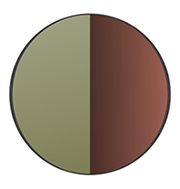Daytime light and weather conditions constantly change while driving and so do Transitions Drivewear sun lenses. Their NuPolar® polarization removes glare off the road and car hood. Transitions® photochromic technology adjusts the color and tint of the lenses as light conditions change, providing ideal color and clarity for driving:
- In low light or overcast conditions, the lenses are a green/yellow color that provides high contrast and minimizes glare
- Behind the windshield, the lenses activate to a copper color enhancing color recognition and depth perception
- In bright outdoor light, the lenses activate to a dark red-brown filtering excess light to provide maximum comfort
- Lenses that work with most prescriptions and frames
COLOR:
Olive Green to Copper to Brown
Get Your Eye Exam and Establish Your Prescription lenses.
It all starts with getting a comprehensive eye exam from an optometrist. During the exam, your optometrist will measure your eyes to determine what type of lens is right for your individual vision needs. They’ll also check for any related conditions that may require special lenses or glasses such as presbyopia (the inability to focus on objects up close) and astigmatism (blurry vision due to an irregularly shaped cornea).
Choose Between Single Vision and Multi-Focal Lens Types.
The type of lenses you need for your glasses will depend on your vision prescription and the way you plan to use them. If you have distance and near vision that both fall within a certain range, you may benefit from single-vision lenses that are made to help with either one or the other. On the other hand, if you have a wider range of prescriptions, multi-focal lenses may be the best option. These lenses combine different powers into one lens so they can help with both near and far distances.
